Cite this document
(Types of Intellectual Property Literature review, n.d.)
Types of Intellectual Property Literature review. Retrieved from https://studentshare.org/social-science/1539415-intellectual-property
Types of Intellectual Property Literature review. Retrieved from https://studentshare.org/social-science/1539415-intellectual-property
(Types of Intellectual Property Literature Review)
Types of Intellectual Property Literature Review. https://studentshare.org/social-science/1539415-intellectual-property.
Types of Intellectual Property Literature Review. https://studentshare.org/social-science/1539415-intellectual-property.
“Types of Intellectual Property Literature Review”, n.d. https://studentshare.org/social-science/1539415-intellectual-property.


